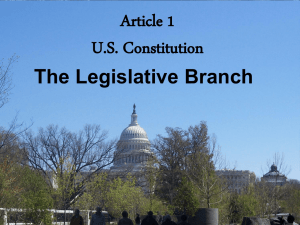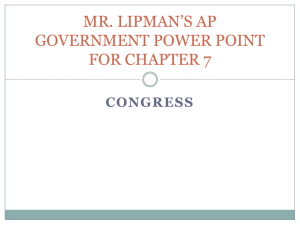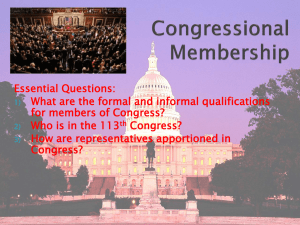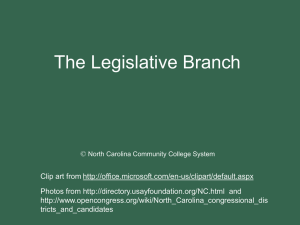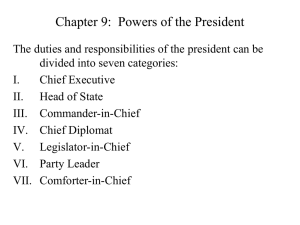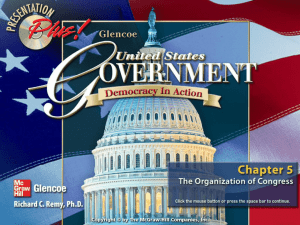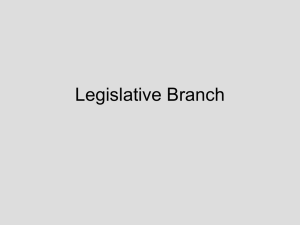Chapter 5 PP Notes-0 - Tri
advertisement
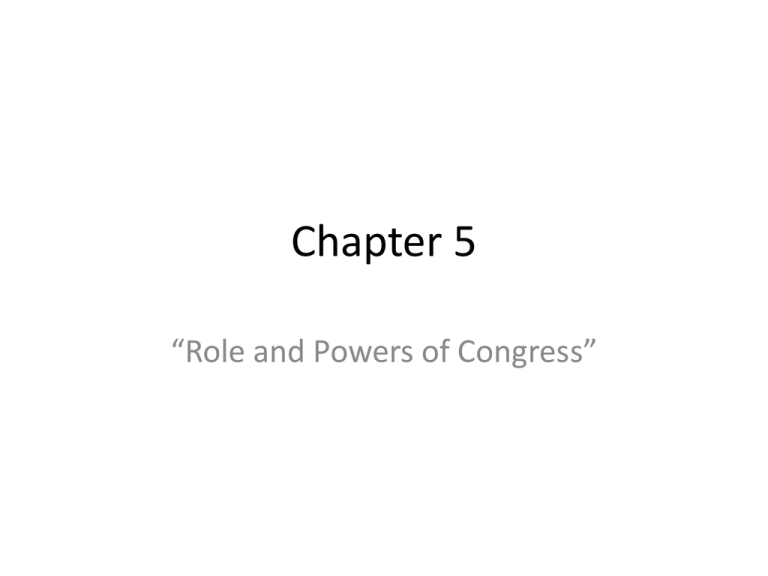
Chapter 5 “Role and Powers of Congress” Section 1: Role of Congress Question: 1. What influences members of Congress to vote the way they do? 2. Imagine you’ve been elected to represent Ohio. •What are the most important issues that you think need addressed? 5.1 Objectives 1. List influences that cause members of Congress to vote the way they do. 2. Identify reasons for congressional investigations. 3. Identify ways members of Congress help their constituents. I. Making Laws Influences: • Personal beliefs • Constituents’ wishes • Interest Groups • Political Party Loyalty – House 201 Democrats, 234 Republicans – Senate: 53 D, 45 R, 2 Independents II. Oversight • Investigation of government programs • Usually focuses on abuses and scandals III. Helping Constituents • 200 million contacts per year • 17% of population has asked for help • Why would someone contact their congressman? Assignment: Read text pages 93-97 Complete section 1 review #2 and #3 on the back of DQ 5.1 5.2 Objectives • Identify qualifications and term lengths for members of the House of Representatives and Senate • Understand how congressional districts are drawn and explain gerrymandering Section 2: Houses and Members of Congress 2nd Session of the 113th Congress I. • • • House of Representatives 435 members 2 year term Seats apportioned based on population, every state guaranteed at least 1 • CA has 53, TX 36, NY 27, FL 27, IL & PA 18, OH 16 Formal Qualifications • 25 years old • Citizen for 7 years • Must live in state elected Informal Qualifications • • • • http://www.nydailynews.com/news/politics/c ost-u-s-senate-seat-10-5-million-article1.1285491 • http://theweek.com/article/index/241194/wh at-it-costs-to-win-a-congressional-election Reapportionment • House grew every 10 years until 1920 (65 in 1789, 435 in 1920) Reapportionment Act of 1929 • Permanent size of 435 • Census determines # per state • Today about 1 rep per every 700,000 people 2003-2012 2013-2022 Congressional Districts • Drawn up by state legislators • Each district must have similar populations • Gerrymandering legal to an extent Gerrymandering…in action In California… In Illinois… •Gerrymandering is only illegal if it favors one race or ethnic group over another. •Political parties can hurt each other by drawing boundary lines that discriminate against the other party. Ohio’s New Congressional Districts 6th Congressional District Bill Johnson (R) Our 6th Congressional District Our old 18th Congressional District Bob Gibbs (R) Gerrymandering Activity •Objective:To get your gender to have has much control over the congressional districts in our state of Scottslyvania. •Based on the 2000 Census, we qualify for 4 congressional seats. •Currently, the Fem Party controls the state legislature and gets to determine how district boundary lines are drawn. •Although there are more members of the Man Party state-wide, most guys don’t vote and the Fem Party wins most of the seats in the state legislature Gerrymandering Scottslyvania Voting Population > 8 Fem + 18 Man = 6.5 per district • Fem Party only has 31% of voting population, but controls 51% of state legislature. • All districts MUST be of equal population, but may not have the same numbers of party members. • How many districts can the Fem Party control? II. Senate • • • • _____ members _____ from each state _____ year term (election every 2 years) 17th Amendment (1913) Qualifications • 30 years old • U.S. citizen for 9 years • Live in the state elected House vs. Senate • • • • • Senate much more prestigious Senate is a continuous body, House is not Senate = upper house, House = lower house Neither have term limits Both can expel members for misconduct with a 2/3 vote • Why would senators be less subject to public opinion and special interests? Salary and Benefits • $174,000 • $60,000 pension when 50 with 20 years of service • Office space and staff • Travel paid to home states • Franking privilege • Health insurance • Can only be arrested for serious crimes Assignment: • Read text pages 98-104 • Daily Quiz 5.2 5.3 Objectives 1. Identify examples of expressed and special powers held by Congress. 2. Explain and identify examples of implied powers held by Congress. 3. Identify constitutional limits that exist on congressional powers. Section 3: Power of Congress 1. Expressed Powers (specifically listed) • Tax, pay debt, defense & general welfare of U.S. • Borrow money, coin money • Declare war, maintain an army • Govern Washington, D.C. • Make all laws necessary and proper for enforcing all powers • Page 105 2. Special Powers A. Impeachment • • • • House/Senate/Vice-President/Chief Justice Andrew Johnson – not guilty by 1 vote Bill Clinton – not guilty, 55-45, 50-50 12 judges, 1 cabinet member, 1 senator B. Approving Treaties • • Senate 2/3 vote, not automatic - Treaty of Versailles C. Approving Appointments • • Senate – majority vote / senatorial courtesy Supreme Court justices, ambassadors, cabinet D. Deciding Elections • • House chooses president – 1 vote per state Senate chooses VP – 1 vote per senator 3. Implied Powers (Elastic/Necessary & Proper Clause) • • • Military academies (raise & maintain military) War Powers Resolution (declare war) Federal courts under Supreme Court 4. Limits on Power • No: – Ex post facto laws – Bill of Attainder – Suspending Writ of Habeas Corpus • • • Cannot tax exports Cannot grant titles of nobility Cannot spend money that has not been approved by congress Chart on page 108 • Assignment • Read text pages 105-108 • Complete Daily Quiz 5.3 Friday – Study Guide Monday – Chapter 5 Test

